Publications
CEMMS is a research-driven academic community with a very strong publishing history. There are number of journals, societies and book series associated with the Centre, some of which are detailed below, as well as selected monographs and edited collections published by members of CEMMS.
- Elizabethan Globalism: England, China and the Rainbow Portrait
Elizabethan Globalism: England, China and the Rainbow Portrait
Matthew Dimmock (Yale, 2019)
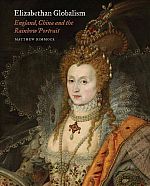 Challenging the myth of Elizabethan England as insular and xenophobic, this revelatory study sheds light on how the nation’s growing global encounters—from the Caribbean to Asia—created an interest and curiosity in the wider world that resonated deeply throughout society. Matthew Dimmock reconstructs an extraordinary housewarming party thrown at the newly built Cecil House in London in 1602 for Elizabeth I where a stunning display of Chinese porcelain served as a physical manifestation of how global trade and diplomacy had led to a new appreciation of foreign cultures.This party was also the likely inspiration for Elizabeth’s celebrated Rainbow Portrait, an image that Dimmock describes as a carefully orchestrated vision of England’s emerging ambitions for its engagements with the rest of the world.
Challenging the myth of Elizabethan England as insular and xenophobic, this revelatory study sheds light on how the nation’s growing global encounters—from the Caribbean to Asia—created an interest and curiosity in the wider world that resonated deeply throughout society. Matthew Dimmock reconstructs an extraordinary housewarming party thrown at the newly built Cecil House in London in 1602 for Elizabeth I where a stunning display of Chinese porcelain served as a physical manifestation of how global trade and diplomacy had led to a new appreciation of foreign cultures.This party was also the likely inspiration for Elizabeth’s celebrated Rainbow Portrait, an image that Dimmock describes as a carefully orchestrated vision of England’s emerging ambitions for its engagements with the rest of the world. - The Typographic Imaginary in Early Modern English Literature
The Typographic Imaginary in Early Modern English Literature
Rachel Stenner (Routledge, 2018)
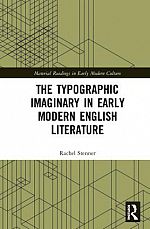 The typographic imaginary is an aesthetic linking authors from William Caxton to Alexander Pope, this study centrally contends. Early modern English literature engages imaginatively with printing and this book both characterizes that engagement and proposes the typographic imaginary as a framework for its analysis. Certain texts, Rachel Stenner states, describe the people, places, concerns, and processes of printing in ways that, over time, generate their own figurative authority.The typographic imaginary is posited as a literary phenomenon shared by different writers, a wider cultural understanding of printing, and a critical concept for unpicking the particular imaginative otherness that printing introduced to literature.
The typographic imaginary is an aesthetic linking authors from William Caxton to Alexander Pope, this study centrally contends. Early modern English literature engages imaginatively with printing and this book both characterizes that engagement and proposes the typographic imaginary as a framework for its analysis. Certain texts, Rachel Stenner states, describe the people, places, concerns, and processes of printing in ways that, over time, generate their own figurative authority.The typographic imaginary is posited as a literary phenomenon shared by different writers, a wider cultural understanding of printing, and a critical concept for unpicking the particular imaginative otherness that printing introduced to literature. - Rereading Chaucer and Spenser: Dan Geffrey with the New Poete
Rereading Chaucer and Spenser: Dan Geffrey with the New Poete
Edited by Rachel Stenner, Tamsin Badcoe, and Garreth Griffith (May, 2019).
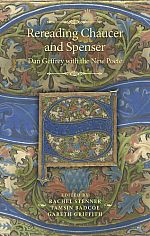 Rereading Chaucer and Spenser is a much-needed volume that brings together established and early career scholars to provide new critical approaches to the relationship between Geoffrey Chaucer and Edmund Spenser. By reading one of the greatest poets of the Middle Ages alongside one of the greatest poets of the English Renaissance, this collection poses questions about poetic authority, influence, and the nature of intertextual relations in a more wide-ranging manner than ever before. With its dual focus on authors from periods often conceived as radically separate, the collection also responds to current interests in periodisation. This approach will engage academics, researchers and students of Medieval and Early Modern culture.
Rereading Chaucer and Spenser is a much-needed volume that brings together established and early career scholars to provide new critical approaches to the relationship between Geoffrey Chaucer and Edmund Spenser. By reading one of the greatest poets of the Middle Ages alongside one of the greatest poets of the English Renaissance, this collection poses questions about poetic authority, influence, and the nature of intertextual relations in a more wide-ranging manner than ever before. With its dual focus on authors from periods often conceived as radically separate, the collection also responds to current interests in periodisation. This approach will engage academics, researchers and students of Medieval and Early Modern culture. - Early Modern Literature in History
Early Modern Literature in History
Edited by Andrew Hadfield alongside Cedric C. Brown (University of Reading)
Within the period 1520-1740, this large, long-running series, with international representation discusses many kinds of writing, both within and outside the established canon. The volumes may employ different theoretical perspectives, but they share an historical awareness and an interest in seeing their texts in lively negotiation with their own and successive cultures.
- Queenship and Counsel in Early Modern Europe
Queenship and Counsel in Early Modern Europe
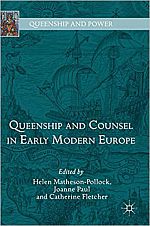 Edited by Helen Matheson- Pollock, Joanne Paul, and Catherine Fletcher. (Palgrave, August 2018).
Edited by Helen Matheson- Pollock, Joanne Paul, and Catherine Fletcher. (Palgrave, August 2018).The discourse of political counsel in early modern Europe depended on the participation of men, as both counsellors and counselled. Women were often thought too irrational or imprudent to give or receive political advice―but they did in unprecedented numbers, as this volume shows. These essays trace the relationship between queenship and counsel through over three hundred years of history. Case studies span Europe, from Sweden and Poland-Lithuania via the Habsburg territories to England and France, and feature queens regnant, consort and regent, including Elizabeth I of England, Catherine Jagiellon of Sweden, Catherine de’ Medici and Anna of Denmark. They draw on a variety of innovative sources to recover evidence of queenly counsel, from treatises and letters to poetry, masques and architecture. For scholars of history, politics and literature in early modern Europe, this book enriches our understanding of royal women as political actors.
- Middle English Mouths: Late Medieval Medical, Religious and Literary Traditions
Middle English Mouths: Late Medieval Medical, Religious and Literary Traditions
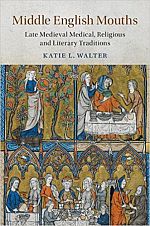 Katie Walter (Cambridge University Press, May 2018)
Katie Walter (Cambridge University Press, May 2018)The mouth, responsible for both physical and spiritual functions - eating, drinking, breathing, praying and confessing - was of immediate importance to medieval thinking about the nature of the human being. Where scholars have traditionally focused on the mouth's grotesque excesses, Katie L. Walter argues for the recuperation of its material 'everyday' aspect. Walter's original study draws on two rich archives: one comprising Middle English theology (Langland, Julian of Norwich, Lydgate, Chaucer) and pastoral writings; the other broadly medical and surgical, including learned encyclopaedias and vernacular translations and treatises. Challenging several critical orthodoxies about the centrality of sight, the hierarchy of the senses and the separation of religious from medical discourses, the book reveals the centrality of the mouth, taste and touch to human modes of knowing and to Christian identity.
- Lying in Early Modern English Culture: From the Oath of Supremacy to the Oath of Allegiance
Lying in Early Modern English Culture: From the Oath of Supremacy to the Oath of Allegiance
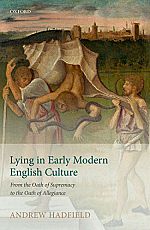 Andrew Hadfield (Oxford University Press, 2017)
Andrew Hadfield (Oxford University Press, 2017) Lying in Early Modern English Culture is a major study of ideas of truth and falsehood in early modern England from the advent of the Reformation to the aftermath of the failed Gunpowder Plot. The period is characterised by panic and chaos when few had any idea how religious, cultural, and social life would develop after the traumatic division of Christendom. While many saw the need for a secular power to define the truth others declared that their allegiances belonged elsewhere. Accordingly there was a constant battle between competing authorities for the right to declare what was the truth and so label opponents as liars. Issues of truth and lying were, therefore, a constant feature of everyday life and determined ideas of individual identity, politics, speech, sex, marriage, and social behaviour, as well as philosophy and religion.
- Thomas More
Thomas More
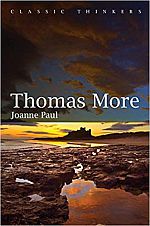 Joanne Paul (Classical Thinkers, December 2016)
Joanne Paul (Classical Thinkers, December 2016)Thomas More remains one of the most enigmatic thinkers in history, due in large part to the enduring mysteres surrounding his best-known work Utopia. He has been variously thought of as a reformer and a conservative, a civic humanist and a devout Christian, a proto-communist and a monarchical absolutist. His work spans contemporary disciplines from history to politics, and his ideas have variously been taken up by seventeenth- century reformers and nineteenth- century communists.
- Special Issue: 'Prosthesis in Medieval and Early Modern Culture'
Special Issue: 'Prosthesis in Medieval and Early Modern Culture'
Eds. Chloe Porter, Katie L. Walter and Margaret Healy, Textual Practice 30.7 (2016)
The first collection of essays dedicated to prosthesis in medieval and early modern English culture, this special issue demonstrates the importance of the 'pre' or 'early' modern to histories and theories of prosthesis. Emerging first as a grammatical term in the English language in the sixteenth century and as a term for medical or bodily supplementation in the eighteenth century, contemporary explorations of prosthesis have often excluded or overlooked the medieval and early modern. Contributions to this issue, however, demonstrate both the longer histories of prosthesis (in medical, religious and dramatic contexts), and the ways in which medieval and early modern literary forms and genres (poetic, dramatic, exemplary, revelatory) can speak to our present-day discourse on this subject.
- A Mirror for Magistrates in Context: Literature, History and Politics in Early Modern England
A Mirror for Magistrates in Context: Literature, History and Politics in Early Modern England
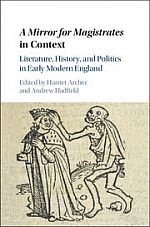 Eds. Harriet Archer and Andrew Hadfield (Cambridge University Press, 2016)
Eds. Harriet Archer and Andrew Hadfield (Cambridge University Press, 2016)This is the first essay collection on A Mirror for Magistrates, the most popular work of English literature in the age of Shakespeare. The Mirror is here analysed by major scholars, who discuss its meaning and significance, and assess the extent of its influence as a series of tragic stories showing powerful princes and governors brought low by fate and enemy action. Scholars debate the challenging and radical nature of the Mirror's politics, its significance as a work of material culture, its relationship to oral culture as print was becoming ever more important, and the complicated evolution of its diverse texts. Other chapters discuss the importance of the book as the first major work that represented Roman history for a literary audience, the sly humour contained in the tragedies and their influence on major writers such as Spenser and Shakespeare.
- The Intellectual Culture of the English Country House, 1500-1700
The Intellectual Culture of the English Country House, 1500-1700
Eds. Matthew Dimmock, Andrew Hadfield and Margaret Healy (Manchester University Press, 2015)
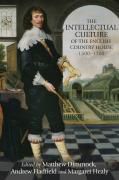 The Intellectual Culture of the English Country House is a ground-breaking collection of essays by leading and emerging scholars, which uncovers the vibrant intellectual life of early modern provincial England. The essays in the volume explore architectural planning; libraries and book collecting; landscape gardening; interior design; the history of science and scientific experimentation; and the collection of portraits and paintings.
The Intellectual Culture of the English Country House is a ground-breaking collection of essays by leading and emerging scholars, which uncovers the vibrant intellectual life of early modern provincial England. The essays in the volume explore architectural planning; libraries and book collecting; landscape gardening; interior design; the history of science and scientific experimentation; and the collection of portraits and paintings.
The essays demonstrate the significance of the English country house (e.g. Knole House, Castle Howard, Penshurst Place) and its place within larger local cultures that it helped to create and shape. They provide a substantial overview of the country house culture of early modern England and the complicated relationship between the provinces and the national, the country and the city, in a period of rapid social, intellectual and economic transformation. It will appeal to anyone interested in the culture of the country house and its place in early modern England. - The Ashgate Research Companion to Popular Culture in Early Modern England
The Ashgate Research Companion to Popular Culture in Early Modern England
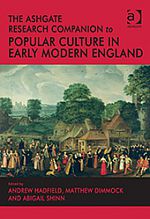 Eds. Andrew Hadfield, Matthew Dimmock and Abigail Shinn (Ashgate, 2014)
Eds. Andrew Hadfield, Matthew Dimmock and Abigail Shinn (Ashgate, 2014)The Ashgate Research Companion to Popular Culture in Early Modern England is a comprehensive, interdisciplinary examination of current research on popular culture in the early modern era. For the first time a detailed yet wide-ranging consideration of the breadth and scope of early modern popular culture in England is collected in one volume, highlighting the interplay of 'low' and 'high' modes of cultural production (while also questioning the validity of such terminology). The authors examine how popular culture impacted upon people's everyday lives during the period, helping to define how individuals and groups experienced the world. Issues as disparate as popular reading cultures, games, food and drink, time, textiles, religious belief and superstition, and the function of festivals and rituals are discussed. This research companion will be an essential resource for scholars and students of early modern history and culture.
- Art, Literature and Religion in Early Modern Sussex
Art, Literature and Religion in Early Modern Sussex
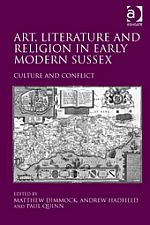 Eds. Matthew Dimmock, Andrew Hadfield and Paul Quinn (Ashgate, 2014)
Eds. Matthew Dimmock, Andrew Hadfield and Paul Quinn (Ashgate, 2014)Art, Literature and Religion in Early Modern Sussex is an interdisciplinary study of a county at the forefront of religious, political and artistic developments in early-modern England. Ranging from the schism of Reformation to the outbreak of Civil War, the volume brings together scholars from the fields of art history, religious and intellectual history and English literature to offer new perspectives on early-modern Sussex.
Essays discuss a wide variety of topics: the coherence of a county divided between East and West and Catholic and Protestant; the art and literary collections of Chichester cathedral; communities of Catholic gentry; Protestant martyrdom; aristocratic education; writing, preaching and exile; local funerary monuments; and the progresses of Elizabeth I. Contributors include Michael Questier; Nigel Llewellyn; Caroline Adams; Karen Coke; and Andrew Foster. The collection concludes with an Afterword by Duncan Salkeld (University of Chichester).
- Making and Unmaking in Early Modern English Drama: Spectators, Aesthetics and Incompletiont
Making and Unmaking in Early Modern English Drama: Spectators, Aesthetics and Incompletion
Chloe Porter (Manchester University Press, 2013)
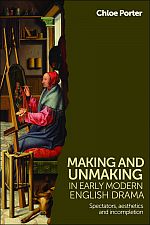 Why are early modern English dramatists preoccupied with unfinished processes of 'making' and 'unmaking'? And what did the terms 'finished' or 'incomplete' mean for dramatists and their audiences in this period? Making and unmaking in early modern English drama is about the significance of visual things that are 'under construction' in works by playwrights including Shakespeare, Robert Greene and John Lyly. Illustrated with examples from across visual and material culture, it opens up new interpretations of the place of aesthetic form in the early modern imagination. Plays are explored as a part of a lively post-Reformation visual culture, alongside a diverse range of contexts and themes, including iconoclasm, painting, sculpture, clothing and jewellery, automata and invisibility. Asking what it meant for Shakespeare and his contemporaries to 'begin' or 'end' a literary or visual work, this book is essential reading for scholars and students of early modern English drama, literature, visual culture and history.
Why are early modern English dramatists preoccupied with unfinished processes of 'making' and 'unmaking'? And what did the terms 'finished' or 'incomplete' mean for dramatists and their audiences in this period? Making and unmaking in early modern English drama is about the significance of visual things that are 'under construction' in works by playwrights including Shakespeare, Robert Greene and John Lyly. Illustrated with examples from across visual and material culture, it opens up new interpretations of the place of aesthetic form in the early modern imagination. Plays are explored as a part of a lively post-Reformation visual culture, alongside a diverse range of contexts and themes, including iconoclasm, painting, sculpture, clothing and jewellery, automata and invisibility. Asking what it meant for Shakespeare and his contemporaries to 'begin' or 'end' a literary or visual work, this book is essential reading for scholars and students of early modern English drama, literature, visual culture and history. - The Oxford Handbook of English Prose 1500-1640
The Oxford Handbook of English Prose 1500-1640
Ed. Andrew Hadfield (Oxford University Press, 2013)
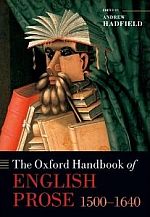 The Oxford Handbook of English Prose 1500-1640 is the only current overview of early modern English prose writing. The aim of the volume is to make prose more visible as a subject and as a mode of writing. It covers a vast range of material vital for the understanding of the period: from jestbooks, newsbooks, and popular romance to the translation of the classics and the pioneering collections of scientific writing and travel writing; from diaries, tracts on witchcraft, and domestic conduct books to rhetorical treatises designed for a courtly audience; from little known works such as William Baldwin's Beware the Cat, probably the first novel in English, to The Bible, The Book of Common Prayer and Richard Hooker's eloquent statement of Anglican belief, The Laws of Ecclesiastical Polity. The work not only deals with the range and variety of the substance and types of English prose, but also analyses the forms and styles of writing adopted in the early modern period, ranging from the Euphuistic nature of prose fiction inaugurated by John Lyly's mannered novel, to the aggressive polemic of the Marprelate controversy; from the scatological humour of comic writing to the careful modulations of the most significant sermons of the age; and from the pithy and concise English essays of Francis Bacon to the ornate and meandering style of John Florio's translation of Montaigne's famous collection. Each essay provides an overview as well as comment on key passages, and a select guide to further reading.
The Oxford Handbook of English Prose 1500-1640 is the only current overview of early modern English prose writing. The aim of the volume is to make prose more visible as a subject and as a mode of writing. It covers a vast range of material vital for the understanding of the period: from jestbooks, newsbooks, and popular romance to the translation of the classics and the pioneering collections of scientific writing and travel writing; from diaries, tracts on witchcraft, and domestic conduct books to rhetorical treatises designed for a courtly audience; from little known works such as William Baldwin's Beware the Cat, probably the first novel in English, to The Bible, The Book of Common Prayer and Richard Hooker's eloquent statement of Anglican belief, The Laws of Ecclesiastical Polity. The work not only deals with the range and variety of the substance and types of English prose, but also analyses the forms and styles of writing adopted in the early modern period, ranging from the Euphuistic nature of prose fiction inaugurated by John Lyly's mannered novel, to the aggressive polemic of the Marprelate controversy; from the scatological humour of comic writing to the careful modulations of the most significant sermons of the age; and from the pithy and concise English essays of Francis Bacon to the ornate and meandering style of John Florio's translation of Montaigne's famous collection. Each essay provides an overview as well as comment on key passages, and a select guide to further reading. - Reading Skin in Medieval Literature and Culture
Reading Skin in Medieval Literature and Culture
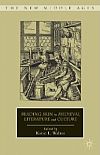 Ed. Katie Walter (Palgrave Macmillan, 2013)
Ed. Katie Walter (Palgrave Macmillan, 2013)Skin is a multifarious image in medieval culture: the material basis for forming a sense of self and relation to the world, as well as a powerful literary and visual image. Treating key medieval English texts and traditions, from romance and exemplum to technical treatises and encyclopedias, the essays in this collection show the subject of skin to be a peculiarly resistant and revealing mode of reading texts, highlighting not the hierarchy, but the interdependency of the senses, and laying bare the intimacy of the human, the animal, the divine and the monstrous in medieval natural philosophy, pastoralia and ethics, and the literary imagination.
- Edmund Spenser – A Life
Edmund Spenser – A Life
Andrew Hadfield (Oxford University Press, 2012)
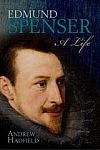 Edmund Spenser's innovative poetic works have a central place in the canon of English literature. Yet he is remembered as a morally flawed, self-interested sycophant; complicit in England's ruthless colonisation of Ireland; in Karl Marx's words, 'Elizabeth's arse-kissing poet' – a man on the make who aspired to be at court and who was prepared to exploit the Irish to get what he wanted. In his vibrant and vivid book, the first biography of the poet for 60 years, Andrew Hadfield finds a more complex and subtle Spenser. How did a man who seemed destined to become a priest or a don become embroiled in politics? If he was intent on social climbing, why was he so astonishingly rude to the good and the great – Lord Burghley, the earl of Leicester, Sir Walter Ralegh, Elizabeth I and James VI? Why was he more at home with 'the middling sort' – writers, publishers and printers, bureaucrats, soldiers, academics, secretaries, and clergymen – than with the mighty and the powerful? How did the appalling slaughter he witnessed in Ireland impact on his imaginative powers? How did his marriage and family life shape his work? Spenser's brilliant writing has always challenged our preconceptions. So too, Hadfield shows, does the contradictory relationship between his between life and his art.
Edmund Spenser's innovative poetic works have a central place in the canon of English literature. Yet he is remembered as a morally flawed, self-interested sycophant; complicit in England's ruthless colonisation of Ireland; in Karl Marx's words, 'Elizabeth's arse-kissing poet' – a man on the make who aspired to be at court and who was prepared to exploit the Irish to get what he wanted. In his vibrant and vivid book, the first biography of the poet for 60 years, Andrew Hadfield finds a more complex and subtle Spenser. How did a man who seemed destined to become a priest or a don become embroiled in politics? If he was intent on social climbing, why was he so astonishingly rude to the good and the great – Lord Burghley, the earl of Leicester, Sir Walter Ralegh, Elizabeth I and James VI? Why was he more at home with 'the middling sort' – writers, publishers and printers, bureaucrats, soldiers, academics, secretaries, and clergymen – than with the mighty and the powerful? How did the appalling slaughter he witnessed in Ireland impact on his imaginative powers? How did his marriage and family life shape his work? Spenser's brilliant writing has always challenged our preconceptions. So too, Hadfield shows, does the contradictory relationship between his between life and his art. - Shakespeare, Alchemy and the Creative Imagination – The Sonnets and 'A Lover's Complaint'
Shakespeare, Alchemy and the Creative Imagination – The Sonnets and 'A Lover's Complaint'
Margaret Healy (Cambridge University Press, 2011)
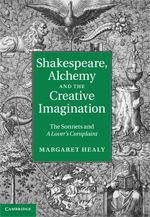 Shakespeare’s Sonnets and A Lover’s Complaint constitute a rich tapestry of rhetorical play about Renaissance love in all its guises.
Shakespeare’s Sonnets and A Lover’s Complaint constitute a rich tapestry of rhetorical play about Renaissance love in all its guises.
A significant strand of this is spiritual alchemy: working the ‘metal’ of the mind through meditation on love, memory work and intense imagination. Healy demonstrates how this process of anguished soul work – construed as essential to inspired poetic making – is woven into these poems, accounting for their most enigmatic imagery and urgency of tone. The esoteric philosophy of late Renaissance Neoplatonic alchemy, which embraced bawdy sexual symbolism and was highly fashionable in European intellectual circles, facilitated Shakespeare’s poetry. Arguing that Shakespeare’s incorporation of alchemical textures throughout his late works is indicative of an artistic stance promoting religious toleration and unity, this book sets out a crucial new framework for interpreting the 1609 poems, and transforms our understanding of Shakespeare's art. - Renaissance Transformations: The Making of English Writing 1500-1650
Renaissance Transformations: The Making of English Writing 1500-1650
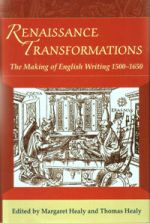 Eds Margaret Healy and Thomas Healy (Edinburgh University Press, 2009)
Eds Margaret Healy and Thomas Healy (Edinburgh University Press, 2009)Renaissance Transformations: The Making of English Writing 1500-1650 is a collection of distinctive new essays that explore the dynamic cultural, intellectual and social processes that shaped literary writing in the Renaissance. Acutely attentive to the complexities that we confront in our attempts to understand the past, twelve leading scholars of Renaissance studies explore significant relations among literary form, material and imaginative culture which compel our attention in the 21st century. This innovative, timely volume is of fundamental importance to all those who study and teach Renaissance literature, history and culture.
- Literature and Popular Culture in Early Modern England
Literature and Popular Culture in Early Modern England
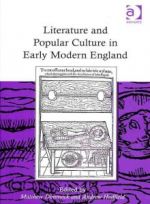 Eds Matthew Dimmock and Andrew Hadfield (Ashgate, 2009)
Eds Matthew Dimmock and Andrew Hadfield (Ashgate, 2009)1978 witnessed the publication of Peter Burke's groundbreaking study Popular Culture in Early Modern Europe. In order to celebrate this achievement, and to explore the ways in which perceptions of popular culture have changed in the intervening years, a group of leading scholars are brought together in this new volume to examine Burke's thesis in relation to England. Taking as its starting point Burke's argument that popular culture was everyone's culture, distinguishing it from high culture, which only a restricted social group could access, the collection explores an intriguing variety of sources to discover whether this was in fact the case in early modern England. It further explores the meaning and significance of the term 'popular culture' when applied to the early modern period: how did people distinguish between high and low culture – could they in fact do so?
- The Building of Elizabethan and Jacobean England
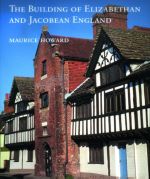 The Building of Elizabethan and Jacobean England
The Building of Elizabethan and Jacobean EnglandMaurice Howard (Yale University Press, 2008)
While the dissolution of the monasteries in the 1530s resulted in the destruction of much of England’s built fabric, it was also a time in which many new initiatives emerged. In the following century, former monasteries were eventually adapted to a variety of uses: royal palaces and country houses, town halls and schools, almshouses and re-fashioned parish churches. In this beautiful and elegantly argued book, Maurice Howard reveals that changes of style in architecture emerged from the practical needs of construction and the self-image of major patrons in the revolutionary century between Reformation and Civil War.
- The Religions of the Book – Christian Perceptions, 1400-1660
The Religions of the Book – Christian Perceptions, 1400-1660
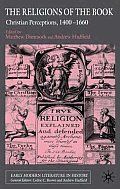 Eds Matthew Dimmock and Andrew Hadfield (Palgrave Macmillan, 2008)
Eds Matthew Dimmock and Andrew Hadfield (Palgrave Macmillan, 2008)The Religions of the Book explores Christian perceptions of the complex relationship between the 'religions of the book' – Christianity, Islam and Judaism – from 1400 to 1660. This period defines the rise of the Islamic Ottoman and the Catholic Spanish Empires, each with rhetorical – if not actual – claims to global dominance, and the apocalyptic conflict between them. It is also a period in which Christianity and Islam were riven by schism, profoundly complicating notions of just and holy war. Similarly, the connections between Christianity and Judaism were subject to continual debate and a wide range of responses. These expansive and interdisciplinary essays question how Christianity was understood in relation to others 'of the book'; the comprehension of common religious narratives and geography; and the nature of their conflict and co-existence. This collection demonstrates how the interaction of these three religions is crucial for an understanding of the period 1400 to 1660.
- New Turkes: Dramatizing Islam and the Ottomans in Early Modern England
New Turkes: Dramatizing Islam and the Ottomans in Early Modern England
Matthew Dimmock (Ashgate, 2005)
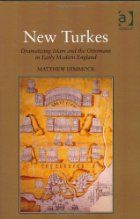 Early Modern England was obsessed with the 'turke'. Following the first Ottoman siege of Vienna in 1529 the printing presses brought endless prayer sheets, pamphlets and books concerning this 'infidel' threat before the public in the vernacular for the first time. As this body of knowledge increased, stimulated by a potent combination of domestic politics, further Ottoman incursions and trade, English notions of Islam and of the 'turke' became nuanced in a way that begins to question the rigid assumptions of traditional critical enquiry. New Turkes: Dramatizing Islam and the Ottomans in Early Modern England explores the ways in which print culture helped define and promulgate a European construction of 'Turkishness' that was nebulous and ever-shifting. By placing in context the developing encounters between the Ottoman and Christian worlds, it shows how ongoing engagements reflected the nature of the 'Turke' in 16th-century English literature. By offering readings of texts by artists, poets and playwrights – especially canonical figures like Kyd, Marlowe and Shakespeare – a bewildering variety of approaches to Islam and the 'turke' is revealed fundamentally questioning any dominant, defining narrative of 'otherness'.
Early Modern England was obsessed with the 'turke'. Following the first Ottoman siege of Vienna in 1529 the printing presses brought endless prayer sheets, pamphlets and books concerning this 'infidel' threat before the public in the vernacular for the first time. As this body of knowledge increased, stimulated by a potent combination of domestic politics, further Ottoman incursions and trade, English notions of Islam and of the 'turke' became nuanced in a way that begins to question the rigid assumptions of traditional critical enquiry. New Turkes: Dramatizing Islam and the Ottomans in Early Modern England explores the ways in which print culture helped define and promulgate a European construction of 'Turkishness' that was nebulous and ever-shifting. By placing in context the developing encounters between the Ottoman and Christian worlds, it shows how ongoing engagements reflected the nature of the 'Turke' in 16th-century English literature. By offering readings of texts by artists, poets and playwrights – especially canonical figures like Kyd, Marlowe and Shakespeare – a bewildering variety of approaches to Islam and the 'turke' is revealed fundamentally questioning any dominant, defining narrative of 'otherness'.